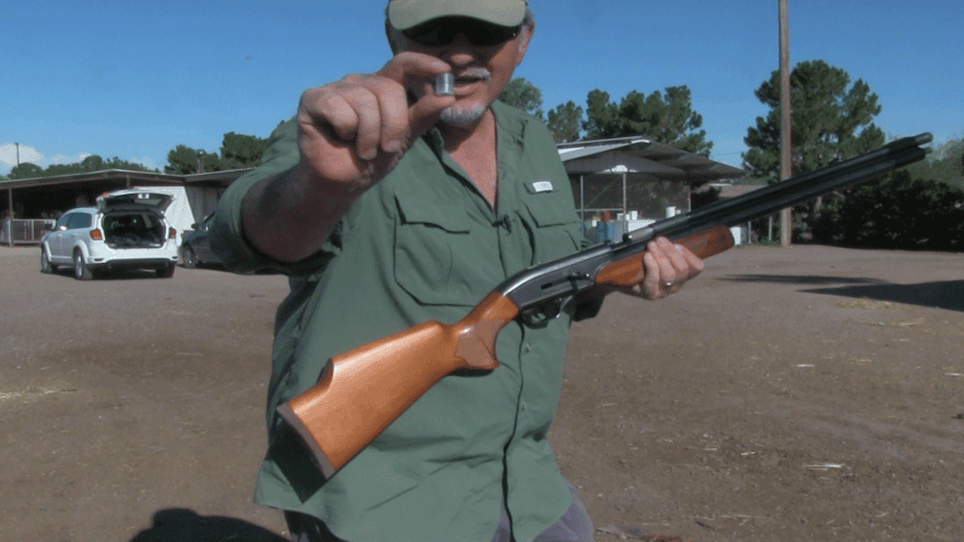I was working around the house a few months ago when my phone rang, and recognizing the number as that of longtime friend and head of Pyramyd/Venturi Airguns Val Gamerman, I answered right away. Val is a busy man and doesn’t call me that often; it’s typically the other way around with me calling him to beg, borrow or steal a new rifle out of the company’s extensive product line.
He started the conversation by saying “Do you remember at SHOT Show when we discussed the concept of an air-powered shotgun?” I replied in the affirmative. “Well, I have a prototype that we’d like you to try out and give us some feedback on,” he continued.
They shipped me the gun and I gave it a go. Long story short, there was a little promise and a lot of problems with that first test. The gun and ammunition delivered a very light pellet density and patterned erratically. The ammunition had to be hand-loaded and was inconsistent and awkward, the stock and sight alignment were all wrong, and the effective range was way too short. So it was back to the drawing board.
From the start, my requirement for an air-powered shotgun was pretty simple: I didn’t expect it to have the range or power of a traditional shotgun, but I did expect it to be a valid hunting tool. This meant it needed to deliver a shot density with enough energy to cleanly kill small game at 25 yards. It needed to offer an adequate shot count on each fill. It had to have a stock and sighting system optimized for quickly mounting and achieving a sight alignment, it had to be consistent, and the shells needed to be sold at a reasonable price.
I had a number of specific recommendations on the original prototype that was built on the platform used for the Sam Yang big-bore airgun. It was based on the company’s .357, and it was suggested that the .457 caliber would probably be a better option. The dual air chamber version of the gun was used in the first test gun, however, the single-reservoir version is capable of generating more power, and I thought this would also balance better. Removing the extra air tube could negatively impact shot count, but any reduction could be mitigated with some clever balancing of the gun’s hammer spring and valve system. The stock was configured for a rifle, and the wrist needed to be a straight shotgun style, the pistol grip and comb needed to be removed, and the rifle sights needed to be replaced with a rib vent and front bead sight.
Val called several weeks later to say a new version was ready to be tested. I was going to be in Arizona taping a Eurasian dove hunt for American Airgunner and thought this would be the perfect test environment for the improved shotgun, now branded the Sam Yang Wing Shot. This gun had many, but not all, of the improvements requested. featuring a .45-caliber smooth bore barrel on the single-reservoir gun with the internal adjustments. A bead sight had been incorporated, but the rib vent had not been added and the new stock was not yet ready.
The gun was using a prototype shot shell that resembled a plastic .45 ACP bullet filled with No. 6 shot. These shells were produced on a 3-D printer and filled by hand, then a rear cap was seated to hold the shot in place. This unique shotgun is a single-shot, with the shell loaded directly into a port situated where the barrel joins up with the receiver. A sleeve is then slid over to seal the loading port and the gun is cocked with a bolt that has two settings (for low and high power). At the high power setting the gun is generating about 850 fps. The effective range with this load was 25 to 30 yards. At 25 yards the shot pattern was about 12 inches diameter with a good distribution of pellets, a dove-sized area being hit by several pellets in every case.
I started testing the gun by shooting Eurasian doves out of trees at 20 to 30 yards, and I found the gun was consistent in anchoring them. Before the criticisms start flying for shooting sitting birds, I’d remind the reader that this is pest control, not sport, so anything that works is fair. Secondly, we were performing field testing before we started wing-shooting. I intend to use this gun for game birds where legal, after ensuring it meets the stated performance criteria. The next round of shooting was on the wing, and with our last box of 50 shells we accounted for 18 birds. I think with more practice these numbers would go up, but because of the lower velocity and smaller shot capacity, passing shots were tough to gauge at first; we did start to improve with time.
This air-powered shotgun is quiet and has a reduced range, making it ideal in more built-up areas. The dairy farm we were shooting on had industrial buildings to one side and a house on another, and though they were both out of shotgun range, firearms couldn’t be used because of noise. This gun would open up a lot of new shooting opportunities for both pest control and bird hunting. There is no doubt that this shotgun takes some getting used to, however, once the shooter gets in a bit of trigger time and understands the guns capabilities, it offers a lot of potential for small game and bird shooting!






